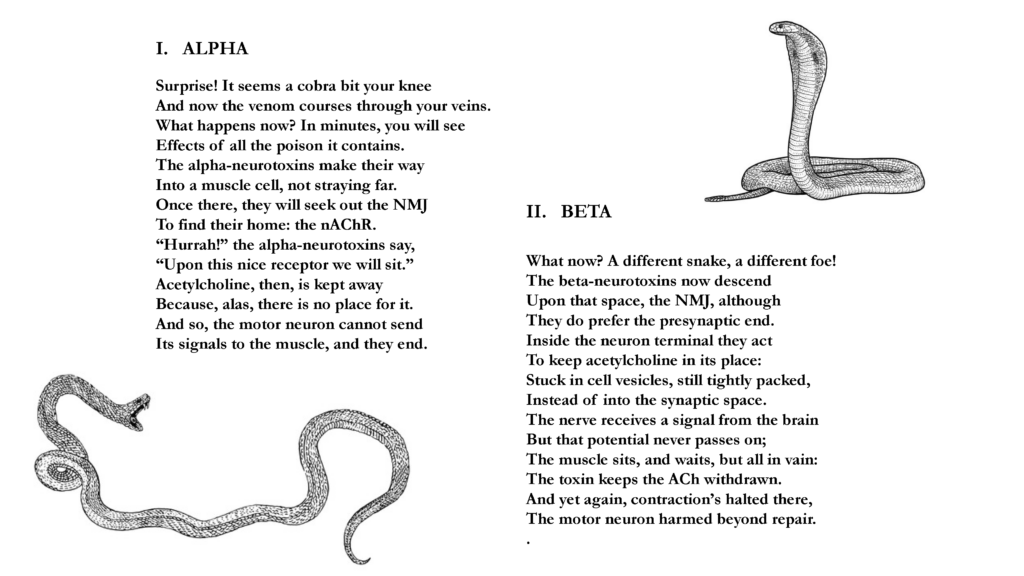For my project I focused on two different types of snake venom toxin (alpha and beta neurotoxins) that target the neuromuscular junction. Both of these toxins interfere with the process of muscle contraction, so the objective I’m addressing here is “Describe how a muscle contraction is induced”.
Because my art skills are not the best (the snakes on the image are stock illustrations and I did not draw them myself I’m sorry) and because I think it’s fun to make things rhyme, I chose to write two poems, one about each type of toxin.
For background: alpha-neurotoxins interfere on the muscle side of the synapse (postsynaptic) by binding to the acetylcholine receptor (nAChR), which means acetylcholine itself (ACh) is unable to bind and propagate signaling once it’s released from the motor neuron. Beta-neurotoxins interfere on the neuron side of the synapse (presynaptic) by causing ACh to remain bound up in vesicles within the neuron terminal so it can’t be released into the synapse at all, and never reaches the nAChR on the muscle side. In both cases, the interference with acetylcholine activity can cause muscle paralysis and weakness throughout the body and can ultimately be fatal if untreated.


Theresa wrote her STEAM project on how a muscle contraction is induced. Theresa chose to take a creative approach to her topic, and she wrote about the relationship between snake venom and muscle contractions. In her project, Theresa described two snake venom toxins. These toxins are alpha-neurotoxins and beta-neurotoxins. For her final product, Theresa wrote two rhyming poems which both describes the effects of the alpha and beta neurotoxins on muscle contractions.
Alpha-neurotoxins is the prominent neurotoxin that is found in snakes. The protein associated with the alpha-neurotoxin binds to the nicotinic acetylcholine receptor (nAChR). When the alpha protein binds to nAChR the process is irreversible thus preventing acetylcholine from binding to the same receptor. Alpha-neurotoxins takes place in the synaptic region. It is vital for acetylcholine to be released from the nerve terminal at the neuromuscular junction so electrical signals can quickly transfer from the nerve to the muscle. If acetylcholine is not able to bind to a receptor, a human might encounter muscle paralysis and if left untreated death may occur.
Beta-neurotoxins is less common than alpha-neurotoxins. Beta-neurotoxins takes place in the presynaptic region. This neurotoxin interrupts the function and process of transmitting electrical signals from the motor neuron. Beta-neurotoxins prevents acetylcholine from being released which later delays/blocks electrical signals from traveling from the nerve to the muscle. When this occurs, the neuron terminal will eventually deteriorate. If a human is bitten from a snake with beta-neurotoxins, it may be more difficult to treat the victim with antivenom and they may endure permanent injury or death.